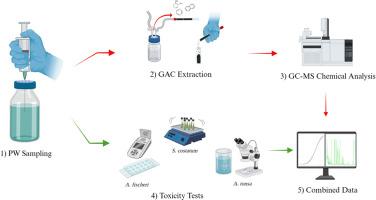采出水废水中挥发性化合物的定量和生态毒理学贡献。
IF 8.1
2区 环境科学与生态学
Q1 ENVIRONMENTAL SCIENCES
引用次数: 0
摘要
采出水 (PW) 是近海石油和天然气生产的重要副产品,是北海的主要废物流。现有法规只针对生产水中的分散脂肪烃含量,对其他潜在危险化合物的关注有限,包括苯、甲苯、乙苯和二甲苯 (BTEX)、多环芳烃 (PAH)、酚类、水溶性石油成分以及与生产相关的化学品。在这项研究中,丹麦石油生产压降样品在颗粒状活性炭上进行了净化和捕集萃取,并通过气相色谱-质谱分析对挥发性化合物进行了鉴定和定量。所获得的分析数据与对整个污水和处理过的样本中的细菌(Aliivibrio fischeri)、藻类(Skeletonema costatum)和桡足类(Acartia tonsa)这三个营养级进行的毒性评估相关。通过净化实验去除 PW 挥发性部分后,受试物种的毒性反应从 37%±23 降至 65%±16。本研究确定的化学物质及其毒性反应提高了对压水污水成分的理解,并为制定近海水库废水处理策略提供了参考。本文章由计算机程序翻译,如有差异,请以英文原文为准。

Quantification and ecotoxicological contribution of volatile compounds in produced water effluents
Produced water (PW) is a significant byproduct of offshore oil and gas production, constituting a major waste stream in the North Sea. Existing regulations address only the dispersed aliphatic hydrocarbon content in PW, and limited attention is given to other potentially hazardous compounds, including benzene, toluene, ethyl benzene and xylene (BTEX), polycyclic aromatic hydrocarbons (PAHs), phenols, water-soluble petroleum constituents as well as production-related chemicals. In this study, Danish oil production PW samples were subjected to purge and trap extraction on granular activated carbon for volatile compounds identification and quantification by GC-MS analysis. The obtained analytical data correlate with toxicity assessments conducted on three trophic levels, bacteria (Aliivibrio fischeri), algae (Skeletonema costatum) and copepods (Acartia tonsa) on the whole effluent as well as on treated samples. The removal of the PW volatile fraction by purging experiments resulted in a decrease in toxicity response from 37% ± 23–65% ± 16 across the tested species. The chemicals identified in this study and their toxicity response enhance the comprehension of the PW effluent composition and inform the development of strategies for offshore reservoir wastewater.
求助全文
通过发布文献求助,成功后即可免费获取论文全文。
去求助
来源期刊

Chemosphere
环境科学-环境科学
CiteScore
15.80
自引率
8.00%
发文量
4975
审稿时长
3.4 months
期刊介绍:
Chemosphere, being an international multidisciplinary journal, is dedicated to publishing original communications and review articles on chemicals in the environment. The scope covers a wide range of topics, including the identification, quantification, behavior, fate, toxicology, treatment, and remediation of chemicals in the bio-, hydro-, litho-, and atmosphere, ensuring the broad dissemination of research in this field.
 求助内容:
求助内容: 应助结果提醒方式:
应助结果提醒方式:


